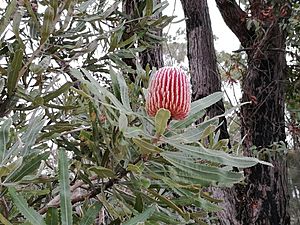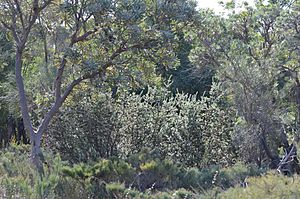Kensington Bushland Reserve facts for kids

The Kensington Bushland Reserve is a special piece of natural bushland. It is located in the suburb of Kensington, in Perth, Western Australia. The state government has set aside this area to protect its unique plants and animals.
This bushland is found west of Kent Street Senior High School. It sits on the north side of Kent Street. A small road called Baron Hay Court marks its western edge. The reserve is next to Harold Rossiter Park and George Reserve to the north. It covers about 9.1 hectares (22.5 acres). In 2000, the government named it "Bush Forever Site 48." This means it is a very important natural area that needs to be protected forever.
The reserve was created in the 1990s. At that time, Kensington was part of the City of Perth council. Now, it is managed by the Town of Victoria Park. It is looked after along with "The Kent Street Sand Pit" and the "George Street Reserve" (an old landfill site). Together, these areas are known as the "Jirdarup Bushland Precinct."
Contents
About the Bushland
The Kensington Bushland Reserve sits on the Bassendean Dune system. This is an old sand dune system. It is the oldest and most easterly of the sand dunes on the Swan Coastal Plain.
Plants of the Bushland (Flora)
The main trees you will find here are Banksia menziesii, Banksia attenuata, and Jarrah (Eucalyptus marginata). As of 2003, scientists have found about 207 different plant species in the bushland. These plants belong to 42 families and 111 groups.
Some unwanted plants, called weeds, are a problem here. The main weeds include Asparagus asparagoides (Bridal Creeper) and perennial veldt grass. Other weeds like Gladiolus caryophyllaceus are also becoming a concern.
This bushland is part of a special group of plants called the Banksia woodlands of the Swan Coastal Plain. This group is now a threatened ecological community. This means it is in danger of disappearing. The biggest threats to these plants are:
- Fragmentation: When the bushland is broken up into smaller pieces.
- Dieback: A disease that kills plants.
- Weed invasion: When unwanted plants take over.
- Inappropriate fire regimes: When fires happen too often or not enough.
- Climate change: Changes in weather patterns.
In February 2016, a bushfire burned about 70% of the native plants in the reserve.
| List of native plants found in Kensington Bushland | |||
|---|---|---|---|
|
| List of Weeds found in Kensington Bushland | |||
|---|---|---|---|
|
Animals of the Bushland (Fauna)
Many interesting animals live in the Kensington Bushland. Some important bird species you might see are:
- Carnaby's Black Cockatoo (Calyptorhynchus latirostris). This bird is endangered, meaning it is at high risk of disappearing forever.
- Forest Red-tailed Black Cockatoo (Calyptorhynchus banksii). This bird is vulnerable, meaning it is also at risk. These cockatoos live in the area all year round.
- Rainbow Bee-eater (Merops ornatus).
In 2017, scientists used special traps to find eight native reptiles. These included the western bobtail (Tiliqua rugosa), dugites (Pseudonaja affinis), the western bearded dragon (Pogona minor), and Buchanan's snake-eyed skink (Cryptoblepharus buchananii).
This small bushland area has been studied a lot. For example, one of the first times the aphid Uroleucon erigeronense was recorded in Australia was here. The day-flying moth, Pollanisus occidentalis, is also very common in the bushland. A new type of robber fly, Cerdistus hudsoni, has only been found in two places so far (as of 2011), and Kensington Bushland is one of them!
Galleries
- Native plants found and photographed in Kensington Bushland reserve
-
Allocasuarina humilis 2018-06-21
-
Calectasia 2007-10-08
-
Pimelea sulphurea 2016-10-09
-
Nuytsia floribunda 2015-10-19
-
Anigozanthos manglesii 2007-10-09
-
Banksia attenuata 2007-10-19
-
Petrophile linearis 2007-10-16
-
Synaphea spinulosa 2007-10-16
-
Daviesia nudiflora 2014-07-12
- Weeds found and photographed in Kensington Bushland reserve




























